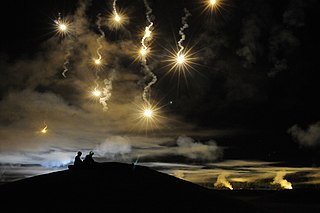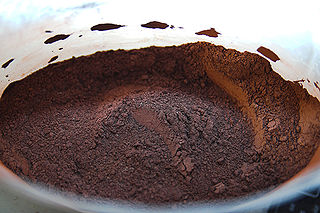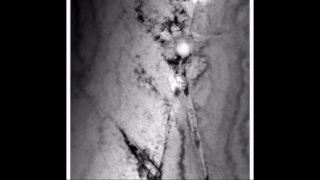Related Research Articles

An explosive is a reactive substance that contains a great amount of potential energy that can produce an explosion if released suddenly, usually accompanied by the production of light, heat, sound, and pressure. An explosive charge is a measured quantity of explosive material, which may either be composed solely of one ingredient or be a mixture containing at least two substances.

A flare, also sometimes called a fusée, fusee, or bengala in some Latin-speaking countries, is a type of pyrotechnic that produces a bright light or intense heat without an explosion. Flares are used for distress signaling, illumination, or defensive countermeasures in civilian and military applications. Flares may be ground pyrotechnics, projectile pyrotechnics, or parachute-suspended to provide maximum illumination time over a large area. Projectile pyrotechnics may be dropped from aircraft, fired from rocket or artillery, or deployed by flare guns or handheld percussive tubes.

Thermite is a pyrotechnic composition of metal powder and metal oxide. When ignited by heat or chemical reaction, thermite undergoes an exothermic reduction-oxidation (redox) reaction. Most varieties are not explosive, but can create brief bursts of heat and high temperature in a small area. Its form of action is similar to that of other fuel-oxidizer mixtures, such as black powder.
A substance is pyrophoric if it ignites spontaneously in air at or below 54 °C (129 °F) or within 5 minutes after coming into contact with air. Examples are organolithium compounds and triethylborane. Pyrophoric materials are often water-reactive as well and will ignite when they contact water or humid air. They can be handled safely in atmospheres of argon or nitrogen. Class D fire extinguishers are designated for use in fires involving pyrophoric materials.

Potassium chlorate is a compound containing potassium, chlorine and oxygen, with the molecular formula KClO3. In its pure form, it is a white crystalline substance. After sodium chlorate, it is the second most common chlorate in industrial use. It is a strong oxidizing agent and its most important application is in safety matches. In other applications it is mostly obsolete and has been replaced by safer alternatives in recent decades. It has been used

A sparkler is a type of hand-held firework that burns slowly while emitting bright, intense colored flames, sparks, and other effects.

Flash powder is a pyrotechnic composition, a mixture of oxidizer and metallic fuel, which burns quickly and if confined produces a loud noise. It is widely used in theatrical pyrotechnics and fireworks and was once used for flashes in photography.

Tannerite is a brand of binary explosive targets used for firearms practice and sold in kit form. The targets comprise a combination of oxidizers and a fuel, primarily aluminium powder, that is supplied as two separate components that are mixed by the user. The combination is relatively stable when subjected to forces less severe than a high-velocity bullet impact. A hammer blow, the product being dropped, or impact from a low-velocity bullet or shotgun blast will not initiate a reaction. It is also designed to be non-flammable, although its explosion can ignite flammable material.
Nano-thermite or super-thermite is a metastable intermolecular composite (MIC) characterized by a particle size of its main constituents, a metal and a metal oxide, under 100 nanometers. This allows for high and customizable reaction rates. Nano-thermites contain an oxidizer and a reducing agent, which are intimately mixed on the nanometer scale. MICs, including nano-thermitic materials, are a type of reactive materials investigated for military use, as well as for general applications involving propellants, explosives, and pyrotechnics.

Zirconium hydride describes an alloy made by combining zirconium and hydrogen. Hydrogen acts as a hardening agent, preventing dislocations in the zirconium atom crystal lattice from sliding past one another. Varying the amount of hydrogen and the form of its presence in the zirconium hydride controls qualities such as the hardness, ductility, and tensile strength of the resulting zirconium hydride. Zirconium hydride with increased hydrogen content can be made harder and stronger than zirconium, but such zirconium hydride is also less ductile than zirconium.

A pyrotechnic fastener is a fastener, usually a nut or bolt, that incorporates a pyrotechnic charge that can be initiated remotely. One or more explosive charges embedded within the bolt are typically activated by an electric current, and the charge breaks the bolt into two or more pieces. The bolt is typically scored around its circumference at the point(s) where the severance should occur. Such bolts are often used in space applications to ensure separation between rocket stages, because they are lighter and much more reliable than mechanical latches.
A pyrotechnic composition is a substance or mixture of substances designed to produce an effect by heat, light, sound, gas/smoke or a combination of these, as a result of non-detonative self-sustaining exothermic chemical reactions. Pyrotechnic substances do not rely on oxygen from external sources to sustain the reaction.
The NASA Standard Initiator (NSI) is a pyrotechnic device used to set off other pyrotechnic devices. It is the central multi-purpose component of a modular system of detonating cords, pyrotechnics and various other explosive charges with many different uses.
A smoke composition is a pyrotechnic composition designed primarily to generate smoke. Smoke compositions are used as obscurants or for generation of signaling smokes. Some are used as a payload of smoke bombs and smoke grenades.
In the U.S. military, reactive materials (RM) are a new class of materials currently being investigated by the Office of Naval Research and others as a means to increase the lethality of direct-hit or fragmentation warheads. Reactive materials are similar to insensitive high explosives, but are usually thermite-like pyrotechnic compositions of two or more nonexplosive solid materials, which stay inert and do not react with each other until subjected to a sufficiently strong mechanical, electrical or laser stimulus, after which they undergo fast burning or explosion with release of high amount of chemical energy in addition to their kinetic energy. Fragments or projectiles made of such materials have therefore greater damaging effect than inert ones, with expected lethality increase up to 500%.
A bridgewire or bridge wire, also known as a hot bridge wire (HBW), is a relatively thin resistance wire used to set off a pyrotechnic composition serving as pyrotechnic initiator. By passing of electric current it is heated to a high temperature that starts the exothermic chemical reaction of the attached composition. After successful firing, the bridgewire melts, resulting in an open circuit.
Delay composition, also called delay charge or delay train, is a pyrotechnic composition, a sort of pyrotechnic initiator, a mixture of oxidizer and fuel that burns in a slow, constant rate that should not be significantly dependent on temperature and pressure. Delay compositions are used to introduce a delay into the firing train, e.g. to properly sequence firing of fireworks, to delay firing of ejection charges in e.g. model rockets, or to introduce a few seconds of time between triggering a hand grenade and its explosion. Typical delay times range between several milliseconds and several seconds.
A pyrotechnic heat source, also called heat pellet, is a pyrotechnic device based on a pyrotechnic composition with a suitable igniter. Its role is to produce controlled amount of heat. Pyrotechnic heat sources are usually based on thermite-like fuel-oxidizer compositions with slow burn rate, high production of heat at desired temperature, and low to zero production of gases.
Reactive multi-layer foils are a class of reactive materials, sometimes referred to as a pyrotechnic initiator of two mutually reactive metals, sputtered to form thin layers that create a laminated foil. On initiation by a heat pulse, delivered by a bridge wire, a laser pulse, an electric spark, a flame, or by other means, the metals undergo self-sustaining exothermic reaction, producing an intermetallic compound. The reaction occurs in solid and liquid phase only, without releasing any gas.
References
- ↑ EPexpired 1128994B1,Karl K. Rink,"Carborane-containing airbag inflator",published 2001-09-05,issued 2004-08-11, assigned to Autoliv ASP Inc.
- ↑ Applications catalog of pyrotechnically actuated devices/systems (PDF). Cleveland, OH: NASA Lewis Research Center. 1 January 1995. pp. 66–67. Archived from the original (PDF) on 22 August 2022.
- ↑ Proceedings of Electric Initiator Symposium - 1963. Franklin Institute, Philadelphia, Pennsylvania: U.S. Army Materiel Command. 1 October 1963. pp. 3–17. Archived from the original (PDF) on 28 May 2018.
- ↑ "Video - Product Compliance Explained". Sphera. 2021-04-12. Retrieved 2021-09-30.
- ↑ ESexpired 2160485B1,Blanes Mira Maria Clara; Carbonell Castell Teresa; Fernandez Ballester Gregorio J; Ferrer Montiel Antonio Vicente; Gil Tebar Ana Isabel; Gutierrez Perez Luis Miguel; Llobregat Hernandez M Mercedes; Perez Paya Enrique; Planell Cases Rosa M; Viniegra Bover Salvador,"Neuron exocytosis inhibitory peptide and cosmetic and pharmaceutical compositions containing the peptide",published 2001-11-01,issued 2002-05-16, assigned to Lipotec SA
- ↑ Koizumi, Hiroyuki; Nakano, Masakatsu; Inoue, Takayoshi; Watanabe, Masashi; Komurasaki, Kimiya; Arakawa, Yoshihiro (2006). "Study on laser ignition of boron/potassium nitrate in vacuum" (PDF). Science and Technology of Energetic Materials. 67 (6): 193–198.
- ↑ USexpired 4391196,Robert E. Betts,"Add-on igniter for pyrogen type igniter",published 1983-07-05,issued 1983-07-05, assigned to US Department of Army
- 1 2 USexpired 6117254,Karl K. Rink, William B. Richardson, David J. Green,"Initiator for airbag inflation gas generation via dissociation",published 2000-09-12,issued 2000-09-12, assigned to Autoliv ASP Inc.
- ↑ Begeal, D. R.; Munger, A. C. Titanium-boron mixtures as variable heat sources. Sandia National Lab., Albuquerque, USA.
- ↑ "PYROFUZE®" (PDF). Sigmund Cohn Corp. Archived from the original (PDF) on 2011-07-16.
- ↑ Joppa, Richard M. (1974). Improved Hot-Wire Electroexplosive Devices (Report). Los Alamos Scientific Laboratory of the University of California. Retrieved 2021-09-30.
- ↑ USexpired 4208967,Robert E. Betts,"Squib design",published 1991-08-06,issued 1991-08-06, assigned to US Department of Army
- ↑ USexpired 5036769,James M. Schaff, Amos J. Diede,"Pyrofuze pin for ordnance activation",published 1983-07-05,issued 1983-07-05, assigned to US Department of Navy
- ↑ Carignan, D. J.; Willian, L. (1978-01-03). Containment and Release Device for Fluids (Report). Department of the Air Force. Archived from the original on September 30, 2021.
- ↑ USexpired 3889755,Byron G Dunn,"Electrical appliance fire extinguisher",published 1975-06-17,issued 1975-06-17, assigned to Fire Fox Corp.
- ↑ USpatent 6672215,Sami Daoud,"Constant output high-precision microcapillary pyrotechnic initiator",published 2004-01-06,issued 2004-01-06, assigned to Textron Innovations Inc.
- ↑ "How to Create an ANNM Detonator from scratch". Pyronfo. 2009-07-01. Archived from the original on 2016-03-09.
- ↑ USexpired 5942717,Claude Pathe, Raphael Trousselle,"Electro-pyrotechnic initiator, method for making same, and vehicle safety system",published 1999-08-24,issued 1999-08-24, assigned to Davey Bickford SAS